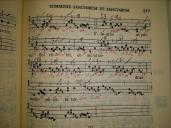Salicus with Horizontal Episema
-
In the Rules for Interpretation, LU xxviij, we read the following:
My schola has had some difficulty while rehearsing the Alleluia for Candlemas. I determined that the problem spot was precisely where the Solesmes edition marks the salicus with a horizontal episema instead of a vertical one at the end of puerum. The same thing occurs at autem, just after the first half bar. See also the Alleluias Justus ut palma and O quam bonus. Are there other examples of this use of the horizontal episema in the rhythmic editions? Any idea why they might have chosen to do it in these chants, despite the aforementioned difficulty in writing it? That, in fact, is precisely the problem for my men: the episema is positioned so closely to the adjacent note that they find it hard to read.In a salicus of three notes, the note marked with the vertical episema must also be lengthened as though it were marked with a horizontal episema (Cf. above : Salicus). Were it not for the difficulty of writing it, the latter would have been used instead.Thanked by 1Jes -
I should think the neume in question is not really a salicus, especially as a true salicus is used on the second syllable of the same word. There is more to it than just the expression on the middle of the three notes. With the salicus, the second note gets the ictus, where as here, on the third syllable of "puerum", the Solesmes rules (I think) would place the ictus on the first note (the note following the dotted note). There are a few other examples of this sort of rhythmic oddity, in which the note with the horizontal episema does not get the ictus. Tricky to conduct, especially when it involves a three-note group.
Justus ut palma would get the same treatment. O quam bonus is interesting because, although it is the same basic melody, the point in question is spread over two syllables. It makes more sense, using the two horizontal episemas, than in the other two examples, which use a dotted note. Why not just condense the O quam bonus neumes into one in the other two cases? Maybe they felt a composite neume could not be made that way, or that the resulting rhythm wasn't correct. Anyone who can read the manuscripts might tell us how the two figures differ there.Thanked by 1Jes -
Thank you! I did check the Triplex after the last rehearsal. After I noted that both L and E indeed have a salicus, I did no further examination of the adiastematic neumes. Since you mentioned the manuscripts, I took a second look. Behold, the last syllable of puerum/palma has five notes—not the four of the Vatican edition! We find two long notes followed by a salicus, with the
topmiddle note marked short in L(which means the middle note is also short). The Novum gives us two unison notes where the episema is in the Solesmes edition, which appears to be authentic. It's a unison salicus, which isn't all that uncommon. I'll be on the lookout for how they're treated elsewhere in the rhythmic edition.
The Novum gives us two unison notes where the episema is in the Solesmes edition, which appears to be authentic. It's a unison salicus, which isn't all that uncommon. I'll be on the lookout for how they're treated elsewhere in the rhythmic edition.
See these editions:
http://www.gregor-und-taube.de/Materialien/Graduale/G.02-02-Darstellung-des-Herrn.pdf
http://gregorianik.uni-regensburg.de/gr/#id/370
 Justus ut palma.jpg811 x 608 - 115KThanked by 1Jes
Justus ut palma.jpg811 x 608 - 115KThanked by 1Jes
Welcome to the MusicaSacra Forum!
To participate in the discussions on Catholic church music, sign in or register as a forum member, The forum is a project of the Church Music Association of America.
Categories
- All Discussions21,168
- General Music Discussion8,243
- Job Openings204
- Management of Music Programs851
- Choral Matters534
- Church Documents and Rubrics526
- CMAA Notes304
- Events720
- For Newcomers: Read First26
- Sacred Polyphony547
- Hymnody872
- Gregorian Chant: General2,703
- ↳ Graduale Romanum and Liber Usualis369
- ↳ Graduale Simplex60
- ↳ Semiology63
- Vernacular Plainsong696
- Anglican Use and Anglican Chant68
- Organ, Other Instruments and Repertoire435
- New Composition/Works in Progress1,295
- Recordings234
- Music for Hispanic Ministry159
- Music Education: Children211
- Music Education: General222
- News Items245
- Positions Wanted2
- General Discussion: Catholicism740
- Amusements177
- General Discussion1,035
- Opinions119
